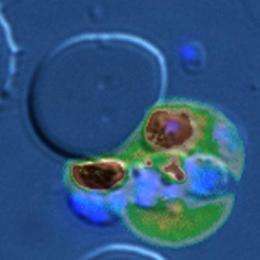Trapping malaria parasites inside host cell basis for new drugs

One of the most insidious ways that parasitic diseases such as malaria and toxoplasmosis wreak their havoc is by hijacking their host's natural cellular processes, turning self against self. Researchers from the Perelman School of Medicine, University of Pennsylvania and Johns Hopkins University, led by Doron Greenbaum, Ph.D., assistant professor of Pharmacology at Penn, have identified the cell signaling pathway used by these parasites to escape from and destroy their host cells and infect new cells—pointing the way toward possible new strategies to stop these diseases in their tracks. The study appears in Cell, Host and Microbe.
When the Plasmodium falciparum and Toxoplasma gondii parasites invade a host cell, they take up residence inside a "parasitophorous vacuole" (PV), growing and replicating themselves for about 48 hours. Then they burst out of the PV, completely destroying and dissolving the protein-based cytoskeleton of their host, freeing themselves to seek out and infect new host cells. Greenbaum's previous work showed that both P. falciparum and T. gondii hijack the calcium-regulated enzyme calpain from host cells and use it to break down host cytoskeleton. The current Cell, Host and Microbe study took the next step of identifying which host signaling pathway was involved, with the aim of derailing the parasite's escape route, trapping it inside the host cell and preventing it from spreading infection.
"We found an entire signaling pathway in the human host cell that the parasite engages, starting from a G-protein-coupled receptor, that the parasite uses to dismantle the cytoskeleton of the host cell, causing it to collapse," Greenbaum explains. "There's a complex series of proteins in this signaling cascade. One of the key proteins is protein kinase C [PKC]. We found a tremendous amount of biological validation for the existence and use of this pathway in both parasitic organisms."
Independent of calpain, the researchers also found that host PKC played an important role in the loss of protein adducin from the host cytoskeleton, contributing greatly to its collapse.
To test the role of the PKC signaling cascade in the disease process, Greenbaum and his collaborators tested known PKC inhibitors in both cell assays and in mouse models. These studies showed a marked decrease in parasitic infection for both P. falciparum and T. gondii. Greenbaum notes, "It's a human enzyme [PKC] that we're targeting, and by inhibiting it we've basically blocked the parasites from getting out. They're trapped and die within the host cells." A key advantage of such an approach, explains Greenbaum, is that "targeting a host protein will engender less resistance because the parasite has no genetic control over the host."
One of the inhibitors tested was a new orally available agent called sotrastaurin, a PKC inhibitor. This drug has already passed Phase I trials and is currently undergoing Phase II trials for various indications. In the mouse studies, sotrastaurin administration also resulted in a significant decrease in parasitemia and markedly increased survival rates against Plasmodium berghei ANKA, thus showing great potential as an oral antimalarial.
"We've piggybacked this line of research onto a drug class that's already vetted," says Greenbaum. "We're quite excited about that. We've found a compound that's already been used in trials in humans and is deemed safe."
Greenbaum and his team are hopeful that after more extensive animal testing, the next step could be human trials of sotrastaurin against malaria. This compound, or similar PKC inhibitors, could provide a multipronged weapon against malaria and other parasitic disease.
"This approach could be used as both a prophylactic and a treatment," Greenbaum says. "We have some indication that it could also used to block transmission."



















